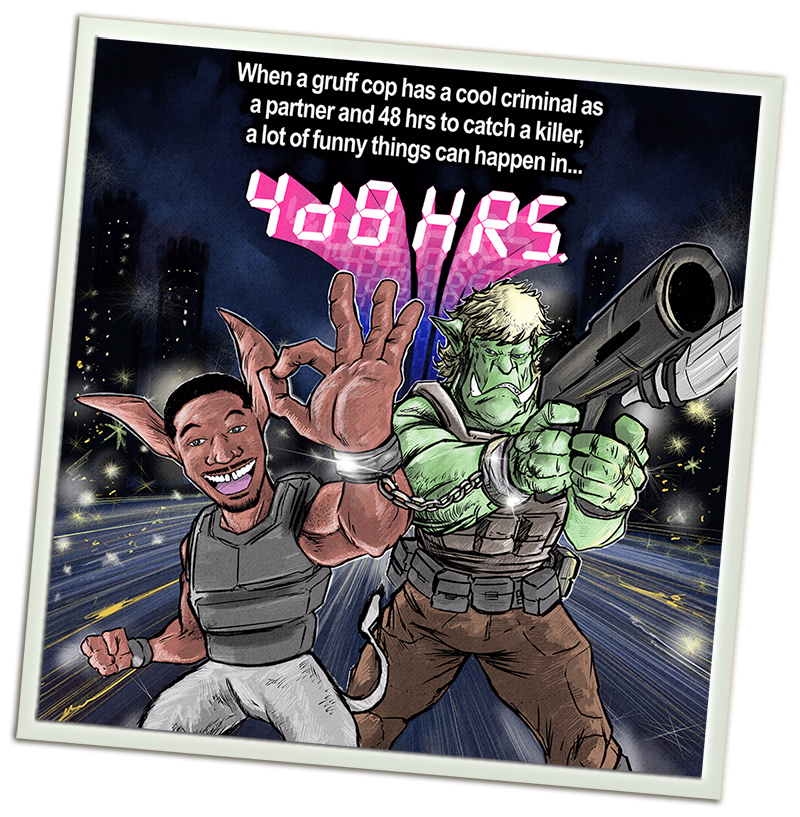An Open Toolbox: SWAT presents both a turn-key playable game and also a basket of mechanics that you can bring to any other Savage Worlds setting. To maximize flexibility and utility, we present our new mechanics in multiple interpretations whenever possible: as setting rules, powers, and edges. We are also publishing all of our mechanics as open license to other Savage Worlds creators so you can reuse, remix, and build upon them in your own work, even commercially, so long as you give credit.
Our goals for the mechanics in SWAT are two-fold: (1) reinvigorate traditional fantasy dungeon crawling by discouraging murder-hobo tactics through the use of a law enforcement lens, and (2) present exciting new modes of play using the language and tropes of film applied through the framing conceit of television/film production.
We don’t have the space in this JumpStart to present our whole concept, but we really want to give you some of the ideas in a form you can add to your own games and play-test.

Style: Games are organized into Scenes, Episodes, and Seasons wherein the tropes of film and language of law enforcement are used copiously to describe the action and enrich player experience: bring cinematic styling to your cinematic action games. Watch as your players bust criminals, rack up convictions, and score killer ratings on the networks.
Toolbox: The new mechanics you’ll have access to can be used in a variety of combinations to model a diversity of styles, including: Documentary realism, Reality TV, Buddy Cop Flicks, Hong Kong WireFu, and Gritty Crime Dramas. New crunch like Continuity Error, Body Double, Stunt Double, Flashbacks and Re-Shoots allow the players to alter the scenes in exciting ways, and new GM tools like Montages, Commercial Breaks, and Highlight Reels give storytellers more options to invoke style and manage the pace of their games.
Dial it up: The main conceit of the game, that characters are being followed and filmed by a cameraman and producer can be dialed up and down: from a simple story telling lens which provides meta-structure, to a series of game mechanics and mini-games that enable players and game masters to steer the action and accrue in-game benefits, all the way up to having players take on the production roles as fully fleshed out classes.
MPAA Rating: Municipal Policing Assault Amplitude Rating measures the degree of lethality Officers are cleared to use in the exercise of their duties. Each rating is associated with an explicit Rules of Engagement detailing the authorizations and limitations on use of force and acceptable policing measures. In-game Municipal Policing Rules of Engagement should produce play that is roughly equivalent to the associated real-world movie ratings.
Rules of Engagement (PG-13):
1. Officers must follow the orders of their Senior Officer.
2. Detention of Civilians is authorized for security reasons or in self-defense.
3. Detained Civilians must be read their Propaganda Rights.
4. Officers may not seize the property of others except as outlined in the Uncivil Forfeiture guidelines.
5. When Officers are attacked by unarmed hostile elements, mobs, or rioters, Officers should use the minimum force necessary under the circumstances and proportional to the threat.
6. Officers have the right to use reasonable force to effect an arrest or protect yourself or others from imminent harm.
7. Officers may use deadly force when the suspect poses a significant threat of death to the officer or others.
8. Officers may give Chase to effect an arrest of persons which pose an imminent threat or to prevent the escape of suspects of a felony level offense.
9. When initiation of ranged fire is necessary, Officers must engage specific targets with aimed shots and not engage in “cover fire” or “fire for effect” tactics. Hostile fire may be returned effectively and promptly to stop a hostile act.
10. Proper warning must be given before Officers engage in the use of force, e.g. “Halt,” or “Stop or I will open fire!”
11. Officers must use no more force than what is necessary to neutralize the threat.
12. Officers must take all reasonable precautions to not injure anyone other than the target.
13. Officers will treat all persons with dignity and respect.
RATINGS BOOST
A ratings Boost is a modified version of Conviction tokens in SWADE. In addition to the normal use of a Conviction token, a Ratings Boost may be spent on powerful and cinematic game mechanics as described below. Players may only have one Ratings Boost at a time, and they are retained until spent, even between sessions.
A Ratings Boost can be earned in all the same ways as a Conviction token and also in the following ways (and the GM is of course encouraged to award these for outlandish behavior over and above what would normally earn a Benny).
Steal the Spotlight: A character may do something “for the camera” where they ham it up, do something risky, or otherwise draw attention from the audience or enemies, for increased ratings. Before taking an action that is appropriate to the episode’s MPAA Rating (e.g. only non-lethal actions for PG-13 and under), the player declares that they are “stealing the spotlight” by giving the GM a Benny. The character then performs the action but may not use a Benny to reroll any failures. If successful, the character earns a Ratings Boost. Steal the Spotlight may be attempted only once per character per session.
Book ‘em Danno: When the players successfully resolve a scene where they effect an arrest, one player may take moment to give a brief victory speech, drop a catchphrase, or humorously improvise the reading of the Propaganda Rights. Draw a card. On a spade, the player earns a Ratings Boost, hearts or diamonds a normal Benny, and on a Joker one of each. On a club (careful with that police baton), the Perp gains a Trial token to use against you in their criminal trial–which adds a token to the opposition in a Trial by Mass Combat, or subtracts from the accuser’s total in a Trial by Social Combat. This represents a complication of their arrest: you flubbed the some paperwork, got a bit to handsy during their interrogation, or forgot to read one of their Propaganda Rights. GMs are encouraged to develop Propaganda Rights appropriate for their games and when players improvise a particularly hilarious “right” or draw a Joker, their addition becomes a part of the official rights list that must be recited.
Color Commentary: Once per scene, a character may step out of the action and give color commentary on the current situation to the audience if a camera crew is present. Before initiative cards are passed out, a character may declare that they are providing color commentary instead of receiving a card. Over the course the round, the player then describes the action as seen by the character. All character and adversary actions should be described, with as much detail as possible and in the manner of the setting (e.g. broad comedy or serious police procedural). At the end of the round, the player should make a Performance roll, modified by any amount the GM feels appropriate for the quality of the narration. With a success, the character receives a normal benny, with a raise, the character receives a Ratings Boost.
Triumph and Tragedy: The Triumph and Tragedy descriptions in the Conviction rules from SWADE may also be used to grant a Ratings Boost.
Radio Chatter: In games with medieval level technology, two-way radio-like communication and covert audio surveillance (e.g. wearing a wire) are accomplished by the clever use of Pixies who are working off court mandated community service sentences. Given the Pixies’ questionable loyalty to law enforcement and capricious nature, when characters are communicating over distance using their Pixies, players must send their messages the longest way around the gaming table from source to destination using whispers, as in the game of “Telephone.”
THE SWAT TOOLBOX
SWAT contains not only sets of rules and abilities but also provides guidelines for incorporating those rules at whatever level the GM feels comfortable. In the following section we describe an action or ability, but we don’t define if it is a use of a benny, an edge, a power or a house rule. At the end of the section we provide a table for suggestions on how to incorporate these rules into a campaign. The GM is encouraged to use this table as a checklist to select what effects are desired in the campaign and at what level.
Body Double: Once per session, players may invoke a body double for the remainder of one scene that has the same stats as the player. The body double has two more advancements, allowing for gaining or increasing a skill, edge, raising an attribute, etc. GM approval required (non-magical characters aren’t likely to gain an Arcane Background, for example).
Stunt Double: Once per session, players may spend a Ratings Boost to invoke a “stunt double” for the remainder of the scene. The character receives three counters. These counters can be spent to negate a new wound or a new level of fatigue. When these tokens are spent, the Stunt Double is dismissed and the character begins their next turn Distracted and Vulnerable.

